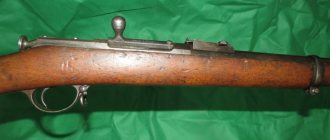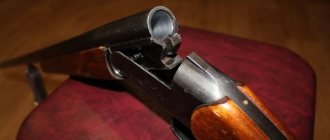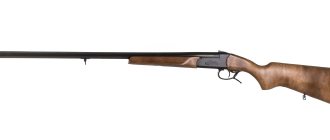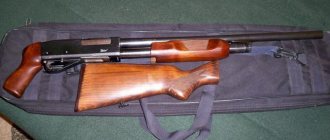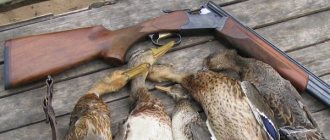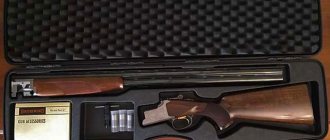Berdanka is the colloquial name for single-shot rifles with a center-fire cartridge, a metal casing and black powder. The inventor of this weapon is considered Hiram Berdan - American military officer, engineer, founder of the 1st Sniper Regiment of the Northern Army in the Civil War. The rifle was adopted by the Russian army in 1868 as a “small rifle of the 1868 model” without mentioning its creator; in documentation the expression “Berdan rifle” was almost always used, and in common parlance simply “Berdanka”.
History of appearance in Russia
In the second half of the 19th century, there was a real disorder in the Russian army in terms of the types of firearms in service. The soldiers used rifles from different manufacturers, firing different calibers of ammunition. This situation did not suit the command, so it was decided to send two officers to the United States - A.P. Gorlov and K.I. Gunius, in order to study the American arms market and select a single model of small arms for the Russian army.
As a result of a long study of various types of rifles and shotguns, the officers came across Heirem Berdan. His rifle seemed to Gorlov and Gunius to be an ideal option - it had high combat characteristics and had a fairly simple design. But the officers did not want to bring a crude sample of rifled weapons to Russia. Therefore, it was decided to modify Berdan’s brainchild to suit the needs of the Russian army. As a result, the total number of design changes reached 35, and the weapon began to be called the “Berdan rifle No. 1.”
The new model entered service with the Russian army in 1871. As weapons spread among military personnel, the armory was busy modernizing the existing version, as well as releasing new versions. In 1877, not only the infantry, but also the grenadier (artillery) and dragoon (cavalry) corps were re-equipped with a rifle. The Berdan rifle was in service with the Russian army until the legendary Mosin rifle appeared in 1891.
Best the enemy of the good?
As a result, the blissful idyll was destroyed... by Hiram Berdan himself. Having waited until the matter with Colt’s order was completely settled,” he rushed to England. There, at the Birmingham plant, he quickly finalized his new version of the shutter - the so-called espagnolette." And then I went even further, to cold and damp St. Petersburg.
Berdan with Russian officers during a visit to St. Petersburg
During comparative tests carried out in Russia, the Experimental Commission noted the superiority of the new rifle over other models, including the old Berdan.” This is how the story of Russian Berdan No. 1 ended, just as it began, and Berdan No. 2 began.
It is interesting that perhaps the most indignant of this fact was... Colonel Gorlov, who was in the USA. In December 1869, he sent a report to Minister of War Milyutin, where he described at length and in detail what a wonderful thing—rifle No. 1, created with his participation at the Colt factory; and what a dubious, untested and generally very, very bad weapon! —Berdan No. 2.”
In his opinion, although she was worse than Berdan No. 1, she was still better than the espagnolette.”
As weapons historians delicately write: It is difficult to say what lay at the heart of Gorlov’s fierce attack on the new system.”
However, Minister Milyutin also turned out to be no fool and responded to all Gorlovsky’s reports with a resolution that the colonel did not provide convincing arguments about the badness of Berdan No. 2. And if so, then there is nothing to talk about. Even a personal visit to Russia by now General Franklin did not help much. From Colt, in addition to the first contract, they agreed to buy only the backlog of components.
Design and mechanism
The Berdanka, which was put into service in 1871, compared to modern rifles, has a number of disadvantages and inconveniences (large weight and dimensions, lack of an extractor, not a very successful cartridge) that are associated with the design of the weapon. In order to shoot and reload the model, it was necessary to perform many actions:
- Pull the key pipe back using the special shank.
- Open the bolt slightly using the ball-shaped handle.
- Insert ammunition into the chamber.
- Return the bolt and key tube to their original position.
- Fire a shot.
- Open the bolt again and release the spent cartridge case.
However, over time, modifications of the Berdanka began to appear, equipped with a sliding bolt, which greatly simplified the process of operating the rifle - the new system itself sent the chamber into the cartridge, and the spent cartridge case was ejected under the action of an extractor when opened.
The rifle stock, which was originally made of hazel, deserves special mention, and over time was replaced by a version made of birch. On the wooden part under the barrel there was a special mount intended for installing a bayonet. And two sliding rings located on the butt and under the barrel made it possible to equip the weapon with a belt so that a soldier could carry it on his shoulder.
A few words about the author of the famous rifle
The inventor of the rifle, Hiram Berdan, was a professional military man. He participated in the American Civil War, although he showed himself only on the bad side.
Hiram was not distinguished by courage, but was an excellent shooter and inventor. One day he came up with a special press designed for gold miners, for which he received a patent. Subsequently, he sold this patent for $200,000, which at that time was simply an astronomical sum.
Having money and position in society, Colonel Berdan created one of the first sniper regiments, consisting of professional hunters. Although they were called cowards in the army, snipers showed how effective their units were during full-scale combat.
Trying to equip his snipers with the most modern rifles, Hiram Berdan more than once encountered a number of shortcomings inherent in the guns of those years. The main problems with the Sharpe rifles used by Colonel Berdan's snipers were due to the use of paper cartridges.
Soon, Colonel Berdaa developed not only a rifle of his own design, but also a cartridge that received a bottle-shaped metal sleeve. This rifle turned out to be so successful that the patent for its production was soon purchased by several European countries, including Russia.
Options and modifications
Different units of the Russian army required different versions of weapons. For example, the cavalry could not use long and bulky rifles, sharpened for shooting from a long distance. This is how the dragoon version of the Berdan rifle No. 2 appeared, which has the following design features:
- significantly shortened barrel - the weapon was distinguished by less accuracy and firing range, but had enormous power;
- lack of a right mount for a bayonet - anyway, the dragoon rarely engaged in close combat, preferring to shoot from a distance of 30 to 70 meters ;
- reduced sight size - for a cavalryman it was important to have a wide viewing angle, and not a sight designed for long-range shooting;
- improved fastening of the stock rings (steel springs instead of screws) - made it possible not to worry about the belt coming off during a gallop;
- reduced powder charge - too much power produced more noise, which frightened the horse.
However, the dragoon version of Berdanka was not suitable for everyone. It especially did not suit the Cossacks, who also made up a significant part of the Russian army. As a result, a Cossack version of the weapon soon appeared, having the following features:
- an even lighter and shorter barrel;
- lack of safety bracket;
- replacing the trigger with a button.
The release of new modifications of Berdanka did not stop there. Following the Cossack rifle, based on the dragoon model, a hunting carbine was released, which was also used to arm light cavalry.
With the advent of the Mosin carbine, the Berdan rifle began to be gradually removed from service. For a long time, about 3 million weapons were simply collecting dust in warehouses (melting down a rifle with such a rich history seemed wasteful). However, with the advent of Soviet power, Berdanka began to appear again in the hands of soldiers - although only in the rear units. Well, since interest in the old model awoke again, in 1930 TOZ decided to start modifying the Berdanka, remaking the design for a smoothbore cartridge of 12, 16, 20, 24 and 32 calibers.
Comparative characteristics[ | ]
Ballistic qualities of rifles from the period after the Franco-Prussian War chambered for standard cartridges according to the results of tests carried out[36][37]
| US Army Weapons Committee | British Army Armament Committee | |||||||||||||||
| Rifle | Mean absolute deviation ( mm ) | Bullet speed ( m /sec) | Trajectory height ( m ) | Weight ( g ) | ||||||||||||
| 457 m | 731.5 m | 960 m | 0 | 460 | 910 | 1400 | 1800 | 460 | 910 | 1400 | 1800 | gunpowder | bullets | |||
| single-shot | Peabody | 424 | dropped out of the trials | no data | ||||||||||||
| single-shot | Greena | 503 | no data | |||||||||||||
| single-shot | Martini-Henry | 261 | 510 | 856 | 401 | 265 | 202 | 155 | 119 | 2,9 | 14,6 | 44,8 | 109 | 5,5 | 31 | |
| single-shot | Berdana | 325 | 678 | 1859 | 440 | 266 | 197 | 145 | 108 | 2,4 | 14,3 | 46,2 | 118,5 | 5 | 24 | |
| single-shot | Beaumont | 416 | dropped out of the trials | no data | 4,5 | 22 | ||||||||||
| store | Vetterli | 574 | 440 | 255 | 181 | 129 | 93 | 2,6 | 15,9 | 53,7 | 143,2 | 4 | 20 | |||
| single-shot | Werndl | "wild" | 439 | 260 | 190 | 137 | 100 | 2,5 | 15 | 49,6 | 129,8 | 5 | 24 | |||
Specifications
Of course, compared to modern models of rifled weapons, the Berdan rifle does not have the best technical characteristics. However, many hunters prefer it not only as a respect for its rich history, but also simply because the carbine is well suited for hunting wild animals and shooting predators. Here are the characteristics of the Berdan rifle (model 1870):
| Characteristic: | Parameter: |
| Caliber | 10.75 (4.2 lines) |
| Cartridge | 10.75x58R |
| Barrel length | 830 mm |
| Overall length (excluding bayonet) | 1300 mm |
| Rate of fire | 8 rounds per minute |
| Initial bullet speed | 437 m/sec |
| Sighting range | 1000 meters |
| Weight | 4.2 kg |
The accuracy of the Berdanka is not very impressive: when fired from a distance of 100 meters, the spread varies from 5 to 7 centimeters . However, this characteristic was increased in modified versions, as were some other aspects mentioned.
Caliber
The wrapper helped protect the cuts from the lead process. In addition, it insulated the metal of the cartridge case and prevented longitudinal tracks from appearing on the bullets. This defect was very common at that time and appeared as they passed through the bore.
The Berdanok bullet had the same caliber as the barrel. She weighed 24.16 grams. When fired, a sufficiently long bullet compressed in length, increased in caliber and filled the rifling. After it flew out, the paper wrapper fell off under air pressure while rotating. On the outside, the bullets with the wrapper were greased, thereby reducing the friction in the barrel when fired. It was very easy to distinguish an infantry cartridge from a cavalry one. The latter's bullet wrapping paper was painted pink, while the infantry cartridge was white. Its weight was 39.4 grams.
The initial speed for an infantry cartridge bullet was 1414 feet, or 431 meters per second, and for a cavalry cartridge - 1188 m/sec. In the first case, she punched three iron sheets, each two and a half millimeters thick, from two hundred paces. Whereas a cavalry bullet could do the same, but from a distance of a hundred meters.
Hunting berdanks
After the Berdan rifle was removed from service with the Russian army, the weapon still continued to be in educational institutions as a training carbine for shooting or hand-to-hand combat. However, most of the Berdanoks were coated with preservative lubricant, packed and sent to the mobilization reserve. Only at the beginning of the 20th century were arms factories allowed to convert rifles into hunting weapons. The Tula Arms Plant was the first to pick up the idea.
In just a few years, the arms market was filled with inexpensive, but fairly high-quality conversion products, which were available to almost every hunter. The price tag for Berdanka varied around 20 rubles, while the average salary for a worker was about 60 rubles. 10.75 caliber cartridges were also relatively inexpensive - a box of 100 pieces cost hunters only 6 rubles.
The price of the Berdan rifle jumped a little after the weapon was converted into a smoothbore and became known as the Frolovka. Such weapons were actively used for hunting game birds and fur-bearing animals, and also had great potential for modernization. The maximum caliber of hunting frolovkas was twelfth (18.5 mm), but most often Russian hunters bought the universal 16th caliber (16.8 mm).
Decline of a rifle's military career
It would seem that after several million copies of Berdanoks were written off, their disposal was only a matter of time. However, the legendary rifle again had to take part in the Second World War. Although the front-line soldiers were still not armed with Berdanka, since at that time there were already many modified models of the three-line rifle (Mosin rifle). But among the rear people, weapons were very widespread.
Despite the fact that the weapon was decommissioned long ago and was more than half a century old, it proved its worth during the defense of important strategic points. Berdanka demonstrated its high potential, so bush producers became interested in it. However, the carbine was not used in wars again - this was the end of his military career.
Handicraft production
The production and sale of homemade Berdankas began even before the First World War. However, it was after the weapon again showed its potential in combat that bush manufacturers began to mass produce modifications of the old rifle. The most popular were the 16, 16, 28 and 32 caliber frolovkas. Manufacturers tried not only to improve their technical characteristics, but also to change their appearance. To do this, a layer of nickel was applied to the metal, as well as decoration in the form of engraving or stamp. On the arms market you can still find many homemade Berdan rifles, which are real works of art.
Berdanka-Frolovka 32 caliber.
Factory assemblies of the gun
The main manufacturer of frolovkas based on Berdanka was the Tula Arms Plant. The company even organized a special workshop that was engaged in drilling out old models and casting new smoothbore barrels of the following calibers:
- 12 (18.5 mm);
- 16 (16.8 mm);
- 20 (15.6 mm);
- 24 (14.7 mm);
- 28 (13.8 mm);
- 32 (12.7 mm).
The most popular calibers were considered the 16th and 20th, since they were best suited to the needs of the Russian hunter. Smaller versions - 28 and 32 calibers - were mainly produced to order. Twenty-four was considered a real rarity and was produced mainly in one-piece versions. Well, the 12th gauge began to appear a little later than the others, when America imposed on Russia the fashion for hunting with this particular cartridge.
Also, few people know that TOZ at one time produced several Berdan rifles using the 44-caliber cartridge (Winchester) for firing. However, there were so few such rifles that now almost no one mentions them.
Who is Kozlevich to share with him?
At first, the cooperation of the two visiting officers with Hiram Berdan developed in the best possible way.
Hiram Berdan
Russian officers (or Berdan from their kicks) made a number of improvements to the rifle. They decided to arrange production at the Colt plant, which was run by another good man - General Franklin.
General Franklin
Since Berdan’s rifle, as it turned out, accidentally contained a few parts that were not entirely his own, the Koltovites nobly proposed the following option: Berdan cedes the rights to the rifle to them, they settle patent problems, and then sell the rifles to everyone - well, I mean, to the Russians.
The only obstacle in this noble cause was the Russian envoy to the United States, Stekl. The same one who recently ruled the sale of Alaska. He circled around and around, and constantly gave all sorts of hints to the Koltovites: there’s no need to negotiate with these two, I’d rather make you an order for 30 thousand rifles. General Franklin even wrote in his diary with indignation - wow, what a bad man! I tried to get into the work of good people for the benefit of Russia...
Berdanki in our time
Many modern hunters and connoisseurs of the classics are concerned about the question of whether it is possible to purchase a Berdan rifle at the present time. Unfortunately, such relics are quite rare for sale. You can find them only in thrift stores or from current owners (there is no point in looking in gun stores). However, you should prepare for the fact that such a model will cost a hefty sum, because its age is almost 150 years. Many collectors even believe that purchasing a Berdanka can be compared to investing in antiques.
Nowadays, Berdanka is a real treasure for connoisseurs of antiques.
The Berdanka is a rather old weapon that is unlikely to surprise a modern hunter with its technical characteristics. Berdan's system is very outdated, so using it to hunt animals is also not very convenient. However, the weapon has a huge advantage over modern rifled carbines - a rich history. The rifle had to take part in two world wars, as well as countless conflicts during the existence of the Russian Empire. So Berdanka should be regarded as nothing more than a relic that needs to be protected and passed on from generation to generation. If you have such a weapon, then you are very lucky.
Notes[ | ]
- ↑ 1 2 Ivanov A.
Weapons of the soldiers-liberators // The echo over the Balkans will not cease. — M.: “Young Guard”; Sofia: “Narodna Mladezh”, 1988. - P. 283. - Description of the Berdan rifle No. 2 at ww1.milua.org
- Small-caliber rapid-fire rifle with a sliding bolt Berdan No. 2 / Compiled by I. I. Zashchuk. - SPb.: type. M-va put. message (A. Behnke), 1874. - 44 p., 2 p. crap.
- R. Ernest Dupuis, Trevor N. Dupuis
World History of Wars (in 4 vols.). book 3 (1800-1925). SPb., M., “Polygon - AST”, 1998. pp. 419-420 - Collection of materials on the Russian-Turkish War of 1877-78. on the Balkan Peninsula [Text]. - St. Petersburg: publication of the Military Historical Commission of the General Staff, 1898-1911 (Type “Thrift”). — 28 cm. Mobilization of the Russian army and concentration in Bessarabia. - 1898. - VIII, 268 p.
- Collection of materials on the Russian-Turkish War of 1877-78. on the Balkan Peninsula. - St. Petersburg: publication of the Military Historical Commission of the General Staff, 1898-1911 (Type “Thrift”). — 28 cm. Mobilization of the Russian army and concentration in Bessarabia. - 1898. - VIII, 268 p. P. 16
- Carbine of the Berdan system of Russian work // “Catalog of guns and hunting accessories for 1898/99. Trading house Ya. Zimina widow and Co.” Moscow, 1898. p. 66
- ↑ 12
A. A. Manikovsky. Russian army in the Great War: Combat supply of the Russian army in the world war. M.: State Military Publishing House, 1937 - M. M. Blum, I. B. Shishkin. Shotgun. M., "Forest industry", 1983. p. 74
- V. N. Shunkov, A. G. Mernikov, A. A. Spector. Russian army in the First World War 1914-1918. M., AST, 2014. p. 54
- History of the Tula Arms Factory, 1712-1972. M., “Thought”, 1973. p. 121
- 10.67-mm (4.2-line) rifle of the Berdan system No. 2 model 1870 // V. N. Shunkov, A. G. Mernikov, A. A. Spektor. Russian army in the First World War 1914-1918. M., AST, 2014. pp. 61-62
- " January 11, 1916.
Now the Northern Front is armed with Japanese rifles and our three-line rifles, the Western Front with only three-line rifles, the Southwestern Front with Austrian and three-line rifles; All German rifles and berdanks were transferred to the rear units. » M. K. Lemke. 250 days at the Tsar's Headquarters 1914-1915. Minsk, Harvest, 2003. - ↑ 1 2 3 4 Yakimovich A. A.
Rifle // Encyclopedic Dictionary of Brockhaus and Efron: in 86 volumes (82 volumes and 4 additional). - St. Petersburg, 1890-1907. - L. E. Sytin.
All about firearms. - "Polygon", 2012. - P. 138. - 646 p. — ISBN 978-5-89173-565-1. - 70mm Mortirka
- Tikhonov, T.1, 2010, p. 542.
- Tikhonov, T.1, 2010, p. 199.
- M. V. Oskin. State militia during the First World War // “Questions of History”, No. 6, June 2013. pp. 142-152
- A. B. Zhuk. Encyclopedia of small arms: revolvers, pistols, rifles, submachine guns, machine guns. M., AST - Voenizdat, 2002. p. 587
- A. A. Kersnovsky. History of the Russian army (in 4 vols.). volume 2. 1814-1881 M., “Voice”, 1993. pp. 246-247
- A. A. Ryabinin. Balkan War. St. Petersburg, 1913. // Small wars of the first half of the 20th century. Balkans. — M: LLC “Publishing House ACT”; St. Petersburg: Terra Fantastica, 2003. - 542, [2] p.: ill. — (Military History Library)
- Small arms of Bulgaria and Turkey during the First World War // “Weapons” magazine, No. 13, 2014. pp. 1-3, 46-58
- ↑ 12
Branko Brankovic. Small arms of Serbia and Montenegro during the First World War // “Weapons” magazine, No. 4, 2014. pp. 1-3, 56-62 - G. V. Tsypkin, V. S. Yagya. History of Ethiopia in modern and contemporary times. M.: “Science”, 1989. p. 111
- War and society in the 20th century. Book 2. War and society on the eve and during the Second World War. / coll. ed., rep. ed. E. N. Kulkov. M., “Science”, 2008. pp. 124-125
- Russian Berdan Rifles Captured by Austro-Hungary
- Branko Bogdanovich. Small arms of Austria-Hungary during the First World War. // magazine "Weapons", No. 7, 2014. pp. 1-3, 46-55
- Konev A. M.
Red Guard in defense of October. — 2nd ed. - M.: Nauka, 1989. - P. 29 - 336 p. - Ten years: (collection of materials from Yu. O. K. Sokolnichesky district: to the 10th anniversary of the October Revolution). - Moscow: Publishing house. Sokolnicheskoy Yu. O. commission., 1927. - 144, 1 p. : ill., portrait; 20 cm.
- “ At the same time, the head of the 4th district of the Omsk district police reported to the provincial police department: “the police officers of the district entrusted to me are poorly armed, namely, with Berdan guns, which in the cold refuse to work and misfire when firing from them.” “
P.F Nikolaev. Omsk police in the first years of Soviet power (1917-1923). Omsk, Archive Department of the Internal Affairs Directorate of the Executive Committee of the Regional Council of Workers' Deputies, 1959. p. 53 - Order of the TsZhOKhR dated December 10, 1925 No. Ahp-2/375// Collection-reference book of official orders on the armed protection of communications, published during the period 1925 - March 1927. / People's Commissariat of Railways, Central Administration of Railway Transport; compiled by the Office of the Chief of Transport Security. - Moscow: Transprint of the NKPS, 1925-1927./ Russian State Library https://www.rsl.ru/
- V. Fedorov. The end of Ataman Cherny (investigator's stories) // magazine "Around the World", No. 6, 1941. pp. 24-32
- Moscow People's Militia. - M.: Moscow worker, 1961. - P. 63.
- Alexey Papkov. "Berdanka". Russian rifle originally from America // Kalashnikov magazine. Weapons, ammunition, equipment", No. 10, 2005. pp. 38-47
- Report of a Board of Ordnance Officers convened under Special Orders No. 107 (Small-Arms Caliber Board). // Ordnance Memoranda
. - Washington, DC: Government Printing Office, 1873. - No. 15 - P. 357-372. - Arbuthnot, R.A.
The New Martini-Enfield Rifle.
// The Engineer
. - July 2, 1886. - Vol. 62 - P. 16.
